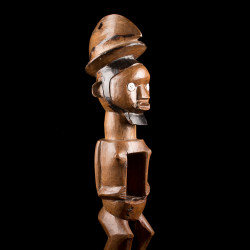












In the traditional artistic corpus of the Teke (ethnic group of Congo Brazzaville), all the statues are executed to be seen from the front during the rites in which they intervene.
The elaborate hairstyles sometimes make it possible to presume the socio-political position occupied by the ancestor represented. Thus the occipital chignon and the median crest are often found among chiefs and high-ranking notables. They evoke, like the beard, the idea of dignity and wisdom.
The tribal statues of the Bateke are involved in various ritual institutions which are essentially based on the notions of nkira and buti.
The bankira (sg. nkira) are nature spirits whose origin is sometimes mythical or indefinite, sometimes historical or familial, and which manifest themselves at the level of political entities or in families (afflictions through various symptoms).
The buti (pl. mat) is this magical entity that the Kongo and the Yaka designate by the term nkisi.
We are only interested here in the buti and the nkira, which use sculpted figurines in their system of representation.
Roughly speaking, it can be said that the nkira define the positive ritual actions which proceed from the will of the ancestors to ensure the well-being of their descendants, whereas in the buti system the actions and the aims aimed at are often ambiguous and selfish.
These two supernatural entities can be associated with various material supports such as statuettes, bark boxes, raffia and cotton packets or sachets, terracotta pots, calabash bottoms, etc.
The consecration of a statuette is carried out according to a precise ritual procedure, which aims to operate a kind of transmutation of the simple object without value to the image, the representation of an ancestor.
The ritual of consecration of a statue like this essentially consists of the preparation of symbolic medicines, their introduction into the various receptacles and the invitation of the spirit to come and occupy the dwelling which is thus prepared for it.
The mass of ingredients that coat the statuette can become so large that it manages to hide the character's entire trunk, which gives it an attitude of balance and power. The object thus consecrated then becomes nkira or buti, that is to say, an object of worship.
The buti charms are many and diverse. Their use covers all areas of life: divination, protection against sorcery and bad luck, easy acquisition of strength or wealth, revenge, etc.
The Teke distinguish three main functional categories of buti: those involved in various therapies (buti bwampaam), hunting "fetishes" (buti bumbyuu) and protection or revenge "fetishes" (ewo).
Bankira charms with carved figurines are mainly ntswo or representations of ancestors who come forward to ensure the well-being of their agnatic descendants.
The nomenclature of these spirits and the rituals devoted to them recall the functions exercised by the ancestors during their lifetime.
There is therefore a varied range of ntswo: ntswo mpu representing an ancestor-chief, ntswo mutsuli, an ancestor-blacksmith and ntswo mubi, an ancestor-hunter, etc.
These ritual objects can only be distinguished from each other at the level of their main functions, the nature of the symbolic substances which fill the receptacles of the statuettes at the time of their consecration, and sometimes by some subsidiary objects which surround them.
There is not always a very clear link between the morphological features of the sculptures and the type of ritual in which they intervene as supports or representations of spirits.
In other words, figurines cannot be classified into distinct morphological types which would coincide with the different functional categories to which they belong.
Data sheet